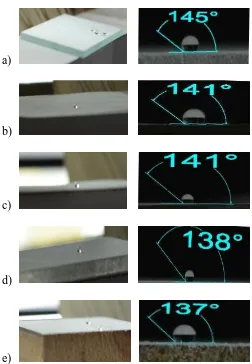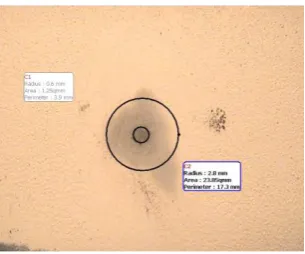SYNTHESIS AND CHARACTERIZATION OF SUPERHYDROPHOBIC
COATINGS
*Waleed Maqsood, E-mail address: waleed.maqsood93@gmail.com , Author
1* Material Engineering Department, NED University of Engineering & Technology, Karachi, Pakistan
ABSTRACT
Superhydrophobic coatings have drawn much attention in recent years because of their unique potential industrial applications. The prepared coating is cheap and versatile and can be applied on various substrates including glass, paper, acrylic, transparency and wood. Furthermore, the SHCs exhibit good long-term stability, water-durability and UV-durability, adapting to out-door environment. Above all, the coatings are environmental, low cost and can be quickly coated on various large-scale substrates, which will widen their practical applications. Two distinct theoretical models have been used to guide the generation of superhydrophobic surface by either roughening the surface or lowering the surface free energy, or both.The increasing interest in studying and manufacturing hydrophobic surface results from their possible practical applications. They find their primary use in corrosion, erosion or general degradation protection applications on metallic, polymer and inorganic oxide (stone, glass, ceramic, etc.) solid surfaces. In recent years, this field has evolved into a major industry trade which covers modern applications from anti-fogging as well as water and snow repellent surfaces for construction materials, glass, automotive and aerospace technology, all the way to reduce frictional drag on airplane wings and ship hulls.
Keywords: Superhydrophobic coating; Long-term stability
1. INTRODUCTION
Nature has a way of designing biological structures to solve challenging science problem. Some familiar instances are the various ways in which plant life and animals cope with either the abundance or scarcity of water. The Lotus foliage’s hierarchical roughness and surface chemistry confer to the leaf superhydrophobic properties; that is, water drops adopt a contact angle greater than 150o and curlicue like marbles under the gentlest forces causation self-cleanup. [3]
Coating having superhydrophobic effect is a nanoscopic surface layer that absorbs water. Droplets to this kind of coating can fully rebound. The vision of production of superhydrophobic surfaces has huge potential applications in the area of corrosion inhibition for metal components, chemical and biological agent protection for clothing, and many other industrial and commercial applications. The wettability of the surface not only affects the fundamental movement of the living
Fig.1 Superhydrophobic Surface
The self-cleaning and water-resistant qualities of superhydrophobic surfaces have the potential for several sensible applications. It can be applied on submarines and oil rigs that are exposed to harsh silane environment and can coatings on marine vessels, submarines and oil rigs which are constantly exposed to a harsh saline environment and also get covered by algae and other marine organisms. [1]
Medical devices with such coatings will greatly reduce risks of infections and contaminations. It also provides protection to building material such as marbles and sandstone from environmental pollution and acid rain. Superhydrophobic paper can be used to make currency notes which will not get soiled easily from the grime and sweat of people using them and this can enhance their longevity. Anti-icing coatings for roads, aircrafts and power lines in cold countries can have the potential of providing enormous economic and safety benefits.
2. EXPERIMENT
2.1 Chemicals & Equipments
Dichloromethane (CH2Cl2, 99.5%), acetone (CH3COCH3), epoxy resin and polyamide resin were from local market. PMMA and Zinc Stearate were arranged fron Metallography Lab (MMD, NEDUET) and they were dried in the oven at 80 °C for 1 h before use. All the substrates (including glass, polymer, paper, metal and wood.) were obtained from local store. The dimensions of substrates were (60 mm*40 mm*5 mm). Before spraying, the substrates were cleaned by ultrasonic
cleaner with acetone and deionized water to remove possible impurities before drying or further use. Equipments needed were weighing machine (for weighing the raw materials), magnetic stirrer, ultrasonicating machine and spray gun, all arranged from Material Department, NEDUET.
2.2 Synthesis
The simple and rapid spraying method was used to fabricate the superhydrophobic surfaces. The binder was prepared by dissolving 0.2g of epoxy resin and 0.1g of polyimide resin (hardener) into 20mL of Dichloromethane. The mixture of PMMA/Zinc Stearate was prepared by dissolving 0.4g of PMMA and 1.6g of Zinc Stearate into 20mL of Dichloromethane. Firstly, the substrates were spray coated with epoxy resin solution and cured at 70oC for 30 min. Then, the epoxy coated substrates were spray-coated again with the Dichloromethane solution with mixture of PMMA/Zinc Stearate and allowed to dry in open air overnight at room temperature.
Fig.2 Flow chart of methodology Procurement of Raw
Materials
Preparation of epoxy solution
Spraying of epoxy solution
Curing
Preparation of PMMA/ZNO solution
Spraying of solution
2.3 Characterization
The superhydrophobicity of the coatings were characterized by contact angle values. The CA was measured by capturing the drop of deionized water on the substrate’s surface, converting it in black and white and then measuring angle through Autocad. For each sample, the CA values were measured at five different positions and the mean value was used as final result.The morphology of superhydrophobic coating was characterized by scanning electron microscope in 5 kV, 3 kV and 2 kV. Scratch test was done to measure the adhesion of the coating. The thickness of the coating was measured by Calo test. FTIR was performed to find the components at the peaks.
3. RESULTS AND DISCUSSION
3.1 SEM Analysis
To understand the superhydrophobic mechanism of the PMMA/ZNO coating, the wettability was investigated. Fig. 3 shows the SEM images of the coating on different magnifications. It can be found that it has rough structure, which may be attribute to the lack of low surface energy materials. It is well known that the spraying method constructed rough skeleton and ZNO particles containing microstructure as the supporting materials filled in rough skeleton in the PMMA/ZNO coating. Because both low surface energy material and rough structure are obtained, the coating can achieve the superhydrophobicity.
Fig. 3 SEM images of coating particles at a) 500X b) 1000X c) 1500X d) 2000X
3.2 Contact Angle
When water droplet was placed on to the superhydrophobic surface, a nearly sphere-like water droplet was formed and steadily stayed on the fabric for extended period periods of time which is similar to that of lotus leaf. Fig. 4 shows contact angle of the water droplet on different substrates.
a)
b)
c)
d)
e)
Fig.4 Contact angle on a) glass b) polymer c) paper d) acrylic e) wood
As shown in the figure, all the substrates showed non-wettability and can repel water. The water droplet can stay on the surface in a sphere shape and roll off easily with slight tilt or shake.
3.3 FTIR Analysis
Fig.5 FT-IR spectra of PMMA/Zinc Stearate coating particles
FT-IR analysis confirms that these peaks increases the surface roughness and lower the surface energy for good superhydrophobicity.
3.4 Thickness Analysis
Calo test was performed to find the coating thickness on the glass substrate. For this, a hardened steel ball having diameter 25mm was turned to gring the layer on glass substrate. Once the film had been abraded off, the projection surface (two circles were formed) was evaluated. The surface was observed in stereomicroscope as shown in fig. 5.
Fig. 6 Stereo micrograph of abraded surface The formula used for the calculation is, Coating Thickness = (X*Y) / ball diameter Where,
X= 2.8 – 0.6 = 2.2mm Y= (0.6*2) + 2.2= 3.4mm Ball diameter = 25mm
Coating thickness = 0.299mm
This coating thickness is the combination of both the epoxy coating and polymer coating on the substrate.
3.5 Adhesion Analysis
Scratch was done to find the adhesion of the coating on the glass sample.
For this, scratches were made on the sample with a sphero-conical stylus which was drawn at a constant speed across the sample, under a constant load, or, more commonly, a progressive load with a fixed loading rate.
The surface was observed in stereomicroscope as shown in fig. 6.
Fig. 7 Stereomicrograph of Scratch test sample The formula used,
Adhesion force = chipping * (maximum load – minimum load)/full scratch length
Adhesion force =30.52N
From the result, it was clearly shown that the force of 30.52N will be required to adhere the coating.
4. CONCLUSION
As summary of this study, we have reported a simple, inexpensive and novel method for fabricating the superhydrophobic coatings for different substrates with the important functions of waterproofing, low surface energy and anti-icing effect. The work can be enhanced to obtain transparency, adjustment of coating to tribological properties and recycling of the coating.
5. ACKNOWLEDGMENTS
6. REFERENCES
[1] Ningning Bai, Qing Li, Hongzhou Dong, Cui Tan, Peng Cai, Lan Xu, “A versatile approach for preparing self-recovering superhydrophobic coatings”,Chemical Engineering Journal, Elsevier B.V., Pages 75-81, 2016.
[2] Weitao Jianga,Hong zhongLiua,Lanlan Wanga,Shuya Zhua,Lei Yina,Yong sheng Shia,Bang dao Chena,Yu cheng Dinga,Ningli Anb, “An effective route for transparent and superhydrophobic coating with high mechanical stability”, Volume 562, 1 July 2014, Pages 383-388.
[3] Zao Chen,Xiaojiang Liu,Yan Wang,JunLi,Zisheng Guan,” Highly transparent, stable, and superhydrophobic coatings based on gradient structure design and fast regeneration from physical damage”.
Volume 359, 30 December 2015, Pages 826-833.
[4] M.Pantoja,F.Velasco,J.Abenojar,M.A.Martinez, “Development of superhydrophobic coatings on AISI 304 austenitic stainless steel with different surface pretreatments”, Volume 671, 1 February 2019, Pages 22-30.
[5] MahendraS.KavaleaD.B.MahadikaV.G.ParaleaP. B.WaghbSatish
C.GuptabA.VenkateswaraRaoaHarish
C.Barshiliac,” Optically transparent, superhydrophobic methyltrimethoxysilane based silica coatings without silylating reagent”,
Volume 258, Issue 1, 15 October 2011, Pages 158-162.
[6] LiangjuanGaoab,JunhuiHea, ”Surface hydrophobic co-modification of hollow silica nanoparticles toward large-area transparent superhydrophobic coatings”, Volume 396, 15 April 2013, Pages 152-159.
[7] Wei-HengHuang,Chao-SungLin,“Robust
superhydrophobic transparent coatings fabricated by a low-temperature sol–gel process”, Volume 305, 30 June 2014, Pages 702-709.
[8] atish A. Mahadik, Vinayak G. Parale, Rajiv S. Vhatkar, Dinesh B. Mahadik, Mahendra S. Kavale, Pratap B. Wagh, Satish C. Gupta, Jyoti L. Gurav,” Superhydrophobic silica coating by dip coating method”, Volume 277, 15 July 2013, Pages 67-72.
[9] Harish C.Barshilia,SijuJohn,VishalMahajan, Nanometric multi-scale rough, transparent and anti-reflective ZnO superhydrophobic coatings on high temperature solar absorber surfaces”,
Volume 107, December 2012, Pages 219-224. [10] XiaojiangLiu,YangXu,KeyangBen,ZaoChen,Ya
nWang,ZishengGuan,”Transparent, durable and thermally stable PDMS-derived superhydrophobic surfaces”, Volume 339, 1 June 2015, Pages 94-101.
[11] Jian Liabc,Hongqi Wana,Yinping Yea,Huidi Zhoua,Jianmin Chena,’ One-step process to fabrication of transparent superhydrophobic SiO2 paper’, Volume 261, 15 November 2012, Pages 470-472.
[12] Jinbin Lin,Hongling Chen,Ting Fei,Jinlong Zhang,” Highly transparent superhydrophobic organic–inorganic nanocoating from the aggregation of silica nanoparticles”, Volume 421, 20 March 2013, Pages 51-62.
[13] Xiaojiang Liu,Yan Wang,Zao Chen,Keyang Ben,Zisheng Guan,” A self-modification approach toward transparent superhydrophobic glass for rainproofing and superhydrophobic fiberglass mesh for oil & water separation”,
Volume 360, Part B, 1 January 2016, Pages 789-797.
[14] Yanfen Wang,Benxia Li,Tongxuan Liu,Chuyang Xu,Zhiwei Ge,” Controllable fabrication of superhydrophobic TiO2 coating with improved transparency and thermostability”, Volume 441, 20 January 2014, Pages 298-305.
[15] Jessica X.H.Wong,Hidehiko Asanuma,Hua-Zhong Yu,” Simple and reproducible method of preparing transparent superhydrophobic glass”,

